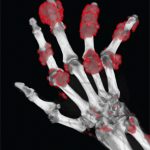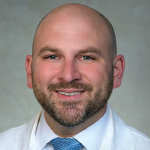Dr. Maher also shared additional newly released analyses. “We saw improvements in other secondary measures, such as DLCO [diffusing capacity of carbon monoxide]; we saw improvements in quality-of-life measures and also global disease activity scores. We saw similar improvements in both groups,” he said.
Dr. Maher noted that the rituximab arm had fewer adverse events compared to cyclophosphamide—particularly gastrointestinal disorders, such as nausea, headaches and number of infusion reactions.
Although not directly related to lung function, the team also found that rituximab led to improved skin thickness, as measured by the modified Rodnan skin score (decrease in 3.4 units); whereas, patients treated with cyclophosphamide showed a slight worsening in skin thickness. Dr. Maher pointed out that these results are in line with recent results from the DESIRES trial, which also showed a benefit in skin thickening from rituximab.8
“Both cyclophosphamide and rituximab led to FVC and quality-of-life improvements in a whole range of patients with CTD-associated ILD. My take home from this is that rituximab should be considered as an alternative to cyclophosphamide in [these patients],” said Dr. Maher.
However, questions remain about the optimal use of these drugs in a clinical setting, including how they might be used with other therapies. Dr. Maher shared, “I think if I were treating some of these patients in clinical practice, I would start them with up-front rituximab and mycophenolate, but because we were making a comparison with cyclophosphamide, we didn’t feel we could build in the mycophenolate component [in the study design]. So there are some additional questions that need answering.”
RAE Initiative Enhances Rheumatology Care on Navajo Nation
Another presenter, Jennifer Mandal, MD, an assistant professor of medicine, the University of California, San Francisco, and director of the Rheumatology Access Expansion (RAE ) Initiative, discussed some of the positive impacts of a virtual education program on primary care provider education in rheumatoid arthritis.
The ACR’s most recent workforce study estimated that the demand for rheumatology providers will more than double the supply by the year 2030.9 This shortage is particularly pronounced in many non-urban areas, and additional ethnic and racial disparities also pose barriers to specialist access.
One example is the Navajo Nation, the largest Indian reservation in the U.S., home to roughly 174,000 resident tribal members across an area five times the size of Connecticut. Dr. Mandal pointed out that only one, full-time, on-site, clinical rheumatologist covers the reservation and that if one fairly redistributed current rheumatology providers across the country, it should have 19 such providers.




